If you’re in the market for a mobile upgrade, this is the list you’re looking for. From big-screen Androids to the latest iPhone flagship, we’ve reviewed the best smartphone options you can buy. And to help you pick which is the right fit for your pocket, we’ve ranked our favourites below.
To test the best smartphone options, our team takes every model out into the real world. That means binge-watching on the bus to measure battery life, snapping all day to bag an album of camera samples, and maxing out the graphics on Genshin Impact to assess processing power. After putting each contender through its paces, we highlight the winning handsets in this guide.
If you’re shopping specifically for the best Android smartphone, we’ve got a separate feature covering exactly that. We’ve also rounded up the best budget phones, the best mid-range mobiles, and our guide to the best small phones.
What’s the best smartphone?
We think the best smartphone you can buy is the Samsung Galaxy S23 Ultra (buy now). Superlative in every respect, the Galaxy S23 Ultra is the complete smartphone package. Design, display, performance, cameras: if you’re willing to pay, this is the best smartphone you can buy right now.
Other best smartphone recommendations
Is the Samsung Galaxy S23 Ultra not right for you? Here are four of the other best smartphones we’d recommend:
The Apple iPhone 15 Pro Max (buy now) is an evolutionary iteration, but if you’re looking for the best iPhone ever made – this is it. You get the pill-shaped cutout called Dynamic Island, wide, ultra-wide and telephoto trio of cameras, unflappable A17 Pro silicon, and USB-C (finally).
The Google Pixel 7a (buy now) confirms that Google is a master of affordable phones and is a lesson in vanilla Android excellence. A neat design and top-spec camera smarts make it a wallet-friendly winner.
The Apple iPhone 13 Mini (buy now) is small but mighty. Apple’s palm-friendly phone delivers the full-fat iPhone experience, with impressive cameras, and flagship performance. It’s a winner if you want a compact mobile.
The OnePlus Open (buy now), with streamlined styling, fantastic cameras and slick software, is now the premium foldable to beat. It features a useful 6.3in cover display and massive 7.82in display when unfolded.
The Google Pixel 8 Pro (buy now) is the ultimate camera phone. It comes with a 50MP main camera, and 48MP wide and telephoto cameras, but it’s not the hard that makes it special – it’s the software. It’s almost impossible to take a bag photo with the Pixel 8 Pro thanks to Google’s clever AI smarts and editing.
The best smartphones you can buy today:

1. Samsung Galaxy S23 Ultra
Stuff Verdict
Productivity, photography and performance abilities that are unrivalled in the Android world.
Pros
- Stunning display and premium design
- Smart S Pen integration
Cons
- Expensive
- Too large for some
| Samsung Galaxy S23 Ultra specs | |
|---|---|
| Screen | 6.8in, 3088×1440 AMOLED, 120Hz |
| Processor | Snapdragon 8 Gen 2 |
| RAM | 8/12GB |
| Storage | 256GB/512GB/1TB |
| Software | Android 13 with OneUI |
| Cameras | 200+12+10+10MP (rear), 12MP (front) |
| Battery | 5000mAh |
| Dimensions | 163×78×8.9mm, 234g |
If you’re shopping for the ultimate smartphone experience in 2023, the Samsung Galaxy S23 Ultra is top of the tree. Superlative in every respect, it exceeded all expectations in testing. Clad in Gorilla Glass Victus 2, it feels equal parts premium and rugged in the hand. Its sizeable 6.8in AMOLED display is sublime on the eyes, while the bundled S Pen stylus is more responsive than ever.
Performance is peerless, courtesy of a Snapdragon 8 Gen 2 CPU running at higher speeds than any rival. The Ultra simply whizzes through almost every app, task and game. The top-spec S23 also has many camera highlights to summarise: from zoom clarity to colour reproduction, it’s 200MP main sensor and trio of secondary lenses are sublime. Yes, you’ll pay handsomely for the privilege of squeezing an S23 Ultra into your pocket. But if you’re willing to do so, your reward will be the best overall smartphone you can buy right now.
- Read more: Samsung Galaxy S23 Ultra review
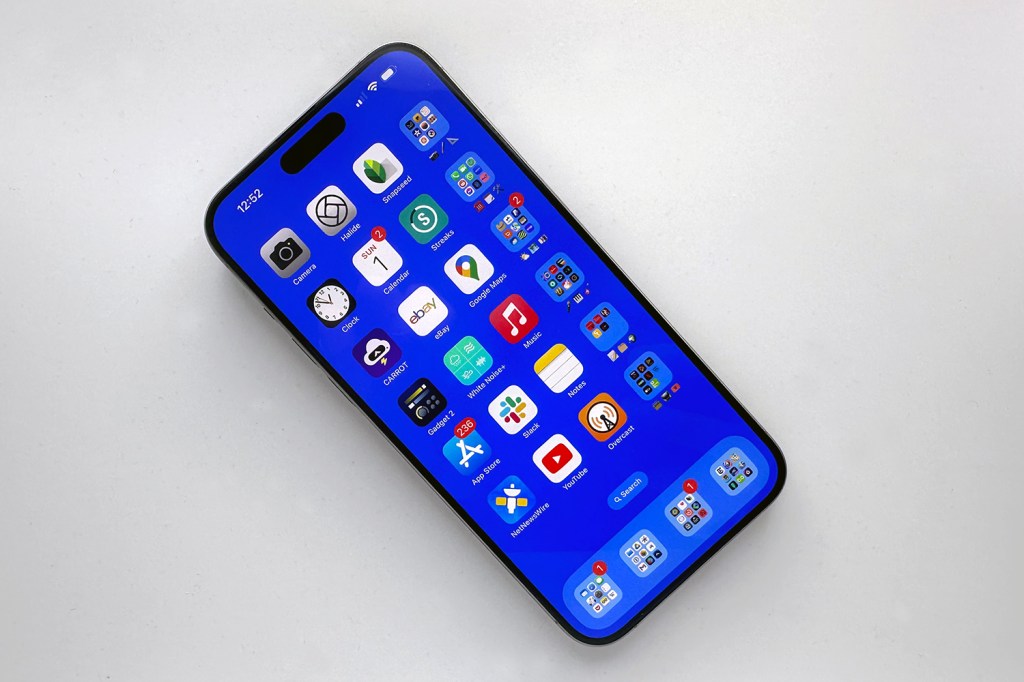
2. Apple iPhone 15 Pro Max
Stuff Verdict
Apple refines its flagship with a better snapper, a slightly svelter form factor and USB-C (finally)
Pros
- Great camera improvements
- USB-C connectivity
- Lighter and nicer to hold
Cons
- USB 3 rather than Thunderbolt
- No desktop mode
| Apple iPhone 15 Pro specs | |
|---|---|
| Screen | 6.7in 2796×1290 OLED HDR, 460ppi |
| Processor | A17 Pro |
| RAM | 8GB |
| Storage | 256GB/512GB/1TB56GB/512GB/1TB |
| Software | iOS 17 |
| Cameras | 48+12+12MP (rear), 12MP (front) |
| Battery | 4,441 mAh (est.) |
| Dimensions | 76.7×159.9×8.25mm, 221g |
This is the best iPhone Apple’s ever made. The camera revisions are great. USB-C was long overdue but is fantastic now it’s here. The Action button is useful. And all this builds on already top-notch components like the display, speakers and app ecosystem.
Of course, you might argue that too much change in the iPhone is iterative rather than revolutionary, although this complaint usually comes from tech journos jaded by dozens of phones flying past their noses every week rather than most normal people who upgrade their phones every other year.
So should you buy one? Not if you already own last year’s Pro Max. The differences aren’t big enough, unless you are a very keen photographer, desperate for USB-C, or have a fetish for chamfered edges. Everyone else? If you can afford it, and if you want the best Apple has to offer, the iPhone 15 Pro Max really is the best.
- Read more: iPhone 15 Pro Max review
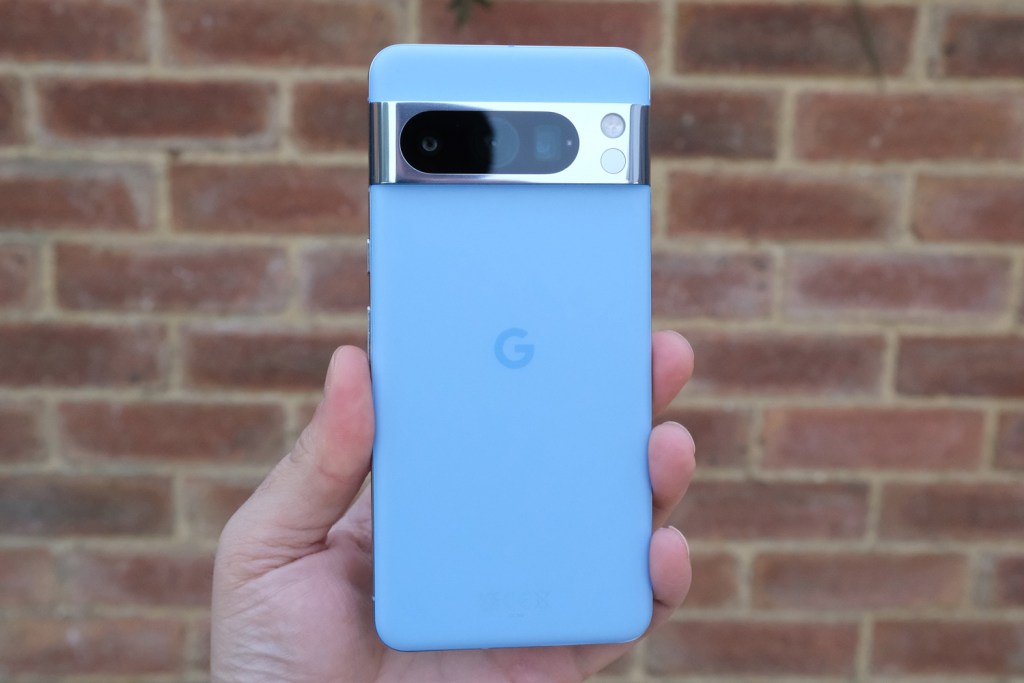
3. Google Pixel 8 Pro
Stuff Verdict
Pixel 8 Pro continues Google’s run of phenomenal phone photography and is more AI-assisted than ever, but it isn’t a value champ like previous Pixels.
Pros
- Fantastic photos in all lighting
- Sharper styling goes far in justifying premium price
Cons
- Higher price makes rivals more tempting
- Battery life and charging speeds still merely OK for a flagship
| Google Pixel 8 Pro specs | |
|---|---|
| Screen | 6.7in, 2992×1344 OLED w/ 1-120Hz, HDR10+ |
| Processor | Google Tensor G3 |
| RAM | 12GB |
| Storage | 128/256/512GB, 1TB (US only) |
| Software | Android 14 |
| Cameras | 50+48+48MP (rear), 10.5MP (front) |
| Battery | 5050mAh |
| Dimensions | 163x77x8.8mm, 213g |
With a design that has matured like a fine wine, a simply stunning screen, and some of the most capable cameras you’ll find on a phone, the Pixel 8 Pro finally feels deserving of that ‘Pro’ label. Even if it comes at the expense of the smaller, cheaper Pixel 8.
Extensive software support means it could earn a place in your pocket for years to come – but that’s not to say there aren’t areas where rivals do things better.
Performance, battery life and charging speeds are good rather than great, and the growing reliance on generative AI is sure to divide opinions. The temperature sensor also feels like a flash in the pan right now.
Previous Pro Pixels had their sore spots, of course. And they also had value on their side. The Pixel 8 Pro still compares favourably on price with the iPhone 15 Pro Max and Galaxy S23 Ultra, but not by a lot. That means you have to be more of a Google die-hard to pick this over the very capable alternatives. You’ll be very happy with your purchase if you do.
- Read more: Google Pixel 8 Pro review
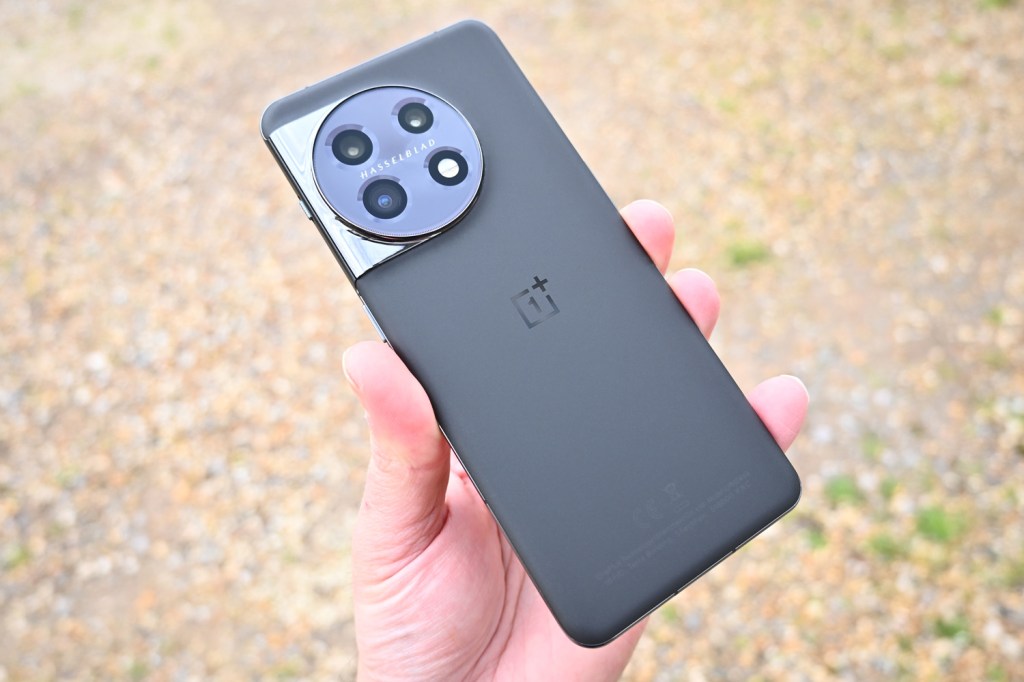
4. OnePlus 11
Stuff Verdict
Almost everything you could ask for from a flagship phone, at a sensible price.
Pros
- Exceptional performance and great battery life
- Beautiful display and punchy speakers
Cons
- No wireless charging a backwards step
- Camera zoom abilities limited
| OnePlus 11 specs | |
|---|---|
| Screen | 6.7in, 3216×1440 AMOLED, 120Hz |
| Processor | Qualcomm Snapdragon 8 Gen 2 |
| RAM | 8/12GB |
| Storage | 128/256/512GB |
| Software | Android 13 with OxygenOS |
| Cameras | 50+48+16MP (rear), 16MP (front) |
| Battery | 5000mAh |
| Dimensions | 163×74×8.5mm, 205g |
Delivering killer specs at a competitive price point, the OnePlus 11 hits a home run. Its all-screen frontage fits the modern mould, complemented by a tactile matte back. The display itself is simply brilliant, with dynamic refresh rates ranging from 1 to 120Hz.
A trademark alert slider marks it out as a OnePlus handset, while Hasselblad branding on the distinctive circular camera bump hints at enhanced shooting modes. Results are great in most conditions, with Pro and 12-bit RAW+ options offering useful flexibility for serious snappers and low-light seeing an improvement from last year.
Performance is predictably superb, while battery life proved impressively frugal throughout our testing. When the 5000mAh cell did run empty, 100W SuperVooc refuelling had it back to full in just over half an hour. If you’re after a flagship bargain, the OnePlus 11 comfortably undercuts every major rival.
- Read more: OnePlus 11 review

5. Nothing Phone 2
Stuff Verdict
This beautiful big-screen blower has unique style and plenty of substance. Rivals have it beat in one or two areas, but none have Phone 2’s charm.
Pros
- Refines everything that Made Phone 1 so fun
- Dependable performance and battery life
Cons
- Rivals still hold the crown for photography
- Not such great value in certain territories
| Nothing Phone 2 specs | |
|---|---|
| Screen | 6.7in, 2410×1080 OLED, 120Hz |
| Processor | Qualcomm Snapdragon 8+ Gen 1 |
| RAM | 8/12GB |
| Storage | 128GB/256GB/512GB |
| Software | Android 13 |
| Cameras | 50MP+50MP (rear), 32MP (front) |
| Battery | 4700mAh |
| Dimensions | 162x76x8.6mm, 201g |
Nothing has taken everything we loved about its debut smartphone effort and turned things up a notch. The glyph interface? It’s smarter now, with more LEDs that better represent countdown timers, incoming notifications and even how long until your Uber driver will turn up. The transparent design? It’s slicker, with slightly curved rear glass that better sits in your hand and a larger 6.7in screen.
Performance is very respectable for a mid-range phone, using last year’s flagship chip, and while the camera hardware hasn’t changed significantly, there are still image quality gains in both daylight and nighttime settings. It’s the NothingOS 2.0 that stands out the most, though: it’s a fantastic spin on Android with consistent styling that puts widgets front and centre. For the money, it’s a very tempting alternative to a Pixel 8 Pro or OnePlus 11.
- Read more: Nothing Phone 2 review
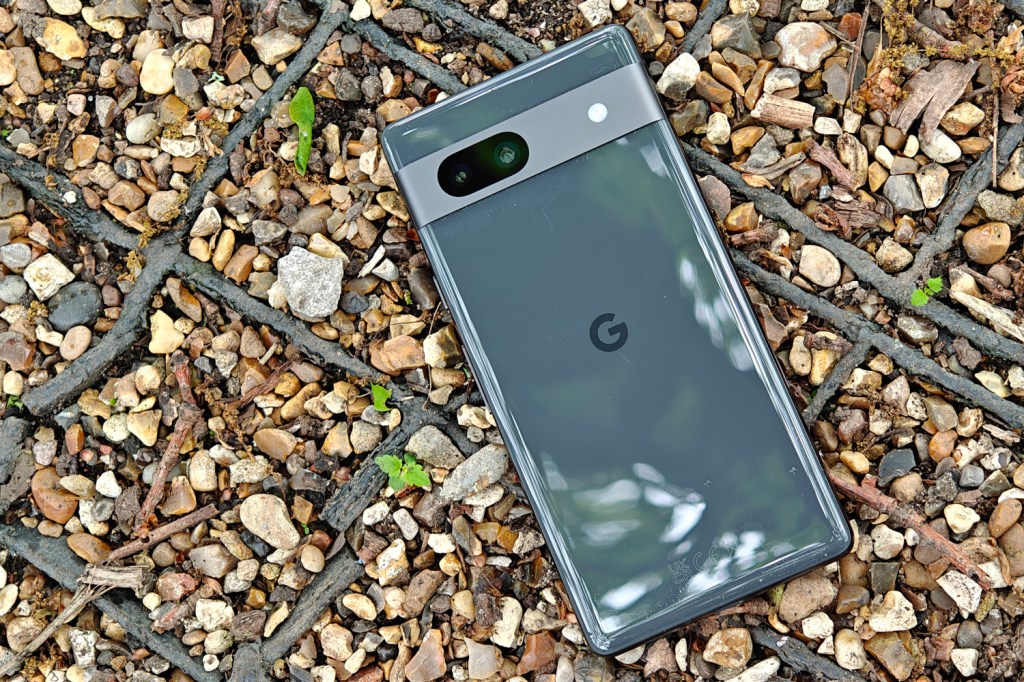
6. Google Pixel 7a
Stuff Verdict
The latest cut-price Pixel isn’t quite as cut-price as its predecessor, but still delivers a software and shooting experience that’s second to none
Pros
- Fantastic still images for a mid-range phone
- Performance punches above its price bracket
Cons
- Price bump over last year’s effort
- Charging speeds remain behind rivals
| Google Pixel 7a specs | |
|---|---|
| Screen | 6.1in, 1080×2400 OLED, 60Hz |
| Processor | Google Tensor G2 |
| RAM | 8GB |
| Storage | 128GB |
| Software | Android 13 |
| Cameras | 64+13MP (rear), 13MP (front) |
| Battery | 4385mAh |
| Dimensions | 152x73x9mm, 193g |
We’ve long been fans of Google’s affordable phones, and the Pixel 7a only continues that record. While not quite as wallet-friendly as its predecessor, this is still as well-rounded a phone and as streamlined an Android experience as you’ll get for the cash. There’s none of the Nothing Phone 1’s snazzy lighting, but the composite shell does a stellar impression of the glass used by its premium cousins. You’re also getting pure Android 13, which the 7a’s Tensor G2 CPU runs without a stutter.
Where the Pixel 67 really excels is in the shooting stakes. With powerful algorithms in its arsenal, almost every image it captures is balanced, noise-free and packed with detail. There’s no telephoto, but autofocus is rapid, while the combination of high pixel count main camera and Night Sight smarts pull true-to-life stills from tricky late-night scenes.
The addition of luxuries like wireless charging and a 90Hz refresh rate, missing on the outgoing Pixel 6a, mean you’ll struggle to find a better all-round Android experience for less.
- Read more: Google Pixel 7a review

7. Sony Xperia 1 V
Stuff Verdict
Another zero-compromise flagship that borrows its best bits from each Sony division. Shoots fantastic stills and videos – though not everyone will want to put in the effort
Pros
- All the manual modes a pro snapper or videographer could want
- Stunning screen and great sound
Cons
- Cameras not as point-and-shoot friendly as rivals
- Serious money
| Sony Xperia 1 V specs | |
|---|---|
| Screen | 6.5in, 1644×3840 OLED, 120Hz |
| Processor | Qualcomm Snapdragon 8 Gen 1 |
| RAM | 12GB |
| Storage | 256GB |
| Software | Android 12 |
| Cameras | 12+12+12MP (rear), 12MP (front) |
| Battery | 5000mAh |
| Dimensions | 165x71x8.3mm, 185g |
The Xperia 1 V isn’t a mainstream mobile, and Sony’s fine with that. It’s a phenomenally capable Android handset, with exceptional performance, a cinematic 4K display and day-long battery life. And it’s packaged in the smartphone equivalent of a sharp business suit. But it has a very clear target market: photographers.
Rapid burst shooting, extensive manual options and stellar image quality make it a serious tool for skilled snappers. Daylight results had exceptional clarity in testing, while images remained sharp, balanced and largely free from noise in low light thanks to an all-new main sensor that relies on pixel-binning cleverness and a new auto Night mode. The 1 V also retains the continuous optical zoom lens of its predecessor, getting you closer to subjects without digital trickery. Sony’s camera app is comprehensive, while object-tracking autofocus is unnaturally fast.
It’s true that rival devices do more to hold your hand, often for a smaller outlay. But fans with deep pockets won’t be disappointed.
- Read more: Sony Xperia 1 V review
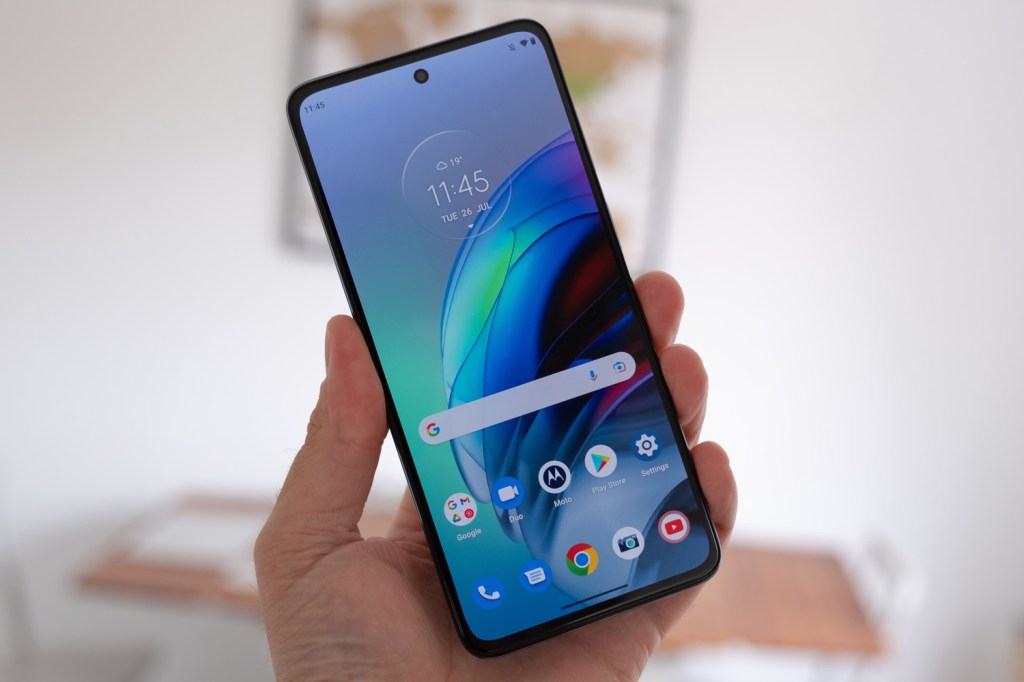
8. Motorola Moto G82
Stuff Verdict
It won’t set your world on fire, but the G82 is long-lasting all-rounder that offers excellent value for money
Pros
- Superb screen for the cash, with high refresh rate
- Stabilised main camera takes impressively clear snaps
Cons
- More powerful rivals don’t cost much more
- Macro camera doesn’t add much value
| Motorola Moto G82 specs | |
|---|---|
| Screen | 6.6in, 2400×1080 AMOLED, 120Hz |
| Processor | Qualcomm Snapdragon 695 5G |
| RAM | 6GB |
| Storage | 128GB (expandable) |
| Software | Android 12 |
| Cameras | 50+8+2MP (rear), 16MP (front) |
| Battery | 5000mAh |
| Dimensions | 160.9x8x74.5mm, 173g |
Not everyone wants to spend the best part of a grand on a smartphone. If your budget’s smaller by two thirds, this sub-£300 smartphone is a steal. The Motorola Moto G82 packs an OLED display with 120Hz refresh rates, a generous 5000mAh battery and an optically stabilised 50MP camera. All features you’d expect from handsets costing a chunk more.
Sure, there are some signs of the compromises required to reach its price point. Its plastic build doesn’t break the G-series mould, while the 2MP macro camera is little more than a token addition. The Snapdragon chip inside won’t set any benchmark records, either.
But thanks to Motorola’s minimal take on Android, overall performance is far from shabby. The main sensor also impresses, producing detailed, realistic images, while the packaging is neat and no-nonsense. If you want a mid-tier mobile that nails the basics at a keen price, this is your pick.
- Read more: Motorola Moto G82 review
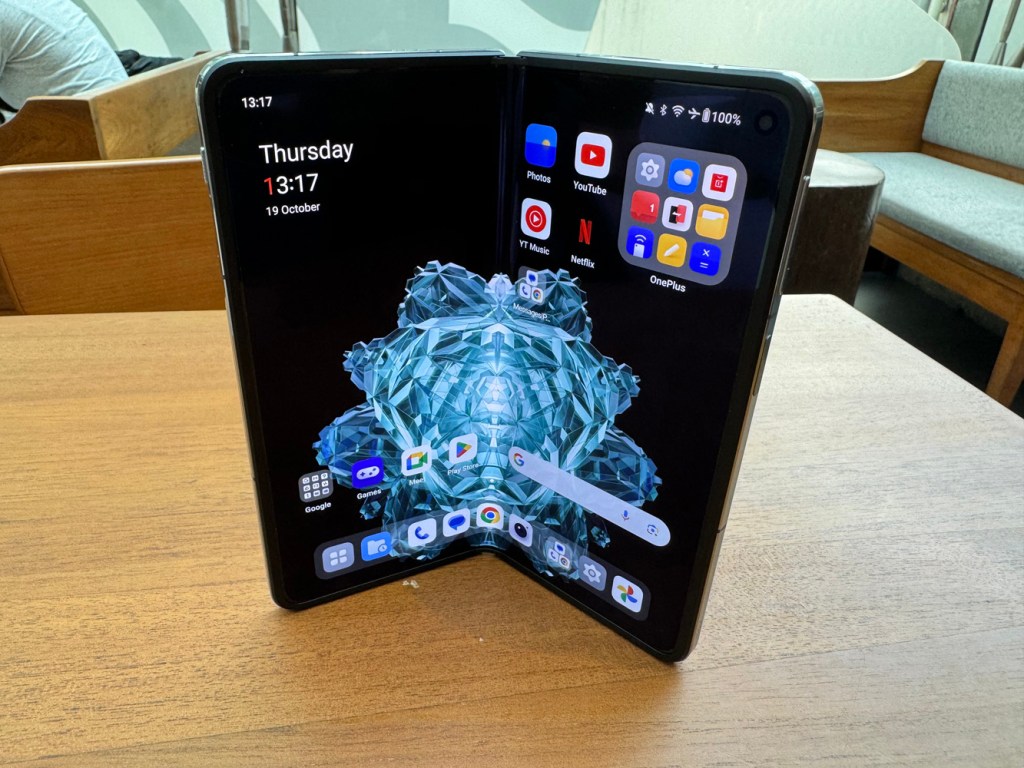
9. OnePlus Open
Stuff Verdict
A brilliant build, capable cameras and some of the best software for multitasking on a foldable phone. The OnePlus Open is the best book-style foldable around, and even costs less than big-name rivals
Pros
- Fabulous build and a high hardware specification
- Brand new camera tech
Cons
- Digital zoom struggles in low light
- Cost, obviously
| OnePlus Open specs | |
|---|---|
| Screen | 6.3in, 2484×1116 AMOLED w/ 120Hz (outer) 7.82in, 2440×2268 AMOLED w/ 120Hz (inner) |
| Processor | Qualcomm Snapdragon 8 Gen 2 |
| RAM | 16GB |
| Storage | 512GB |
| Software | Android 13 w/ OxygenOS |
| Cameras | 48MP + 64MP + 48MP (rear), 32MP (cover), 20MP (inner) |
| Battery | 4805mAh |
| Dimensions | 153x143x5.8mm (unfolded), 153x73x11.7mm (folded), 245g |
It’ll leave a bend in your bank balance, but OnePlus’ first foldable sets a new benchmark for the category. It’s as sturdy and stylish as you’d expect for the price, while only being barely heftier and thicker than a normal handset while folded.
The Snapdragon 8 Gen 2 processor is zippy in the extreme. Top-tier shooting skills come from a trio of clever cameras, with the lead sensor using an all-new stacked design developed by Sony for added low light chops. With colourful OLED tech and 120Hz adaptive refresh rates, the outer panel is as good as you’ll find on any flagship phone. Yet it’s the lesser of the two: the 7.82in screen inside is bright, smooth and vibrant, offering acres of space.
OnePlus has also pulled a blinder with its clever multitasking modes, which let you mix full-screen and split-screen apps with gesture swipes. It’s easily the best we’ve used on a foldable phone. The fact you can grab one for less than either Google Pixel Fold or Samsung Galaxy Z Fold 5 only cements its five-star status.
- Read more: OnePlus Open review
Want more folding phone suggestions? Check out Stuff’s guide to the best folding smartphones.
How to choose the best smartphone for you
In order to buy the best smartphone for your needs, there are several important factors to consider. Luckily, Stuff’s smartphone experts are here to help you compare options and make a final decision.
The first big decision you’ll have to make is choosing between Apple’s iOS and Google’s Android operating systems. Both have their own interface, features, and app ecosystem, so if you have a preference or existing devices with potential compatibility issues, then it’s best to stick with what you’re already familiar with.
One of the next things you’ll need to do is set a budget. Smartphones vary widely in price, from as little as $300/£200 to over $1200/£1000. Once you’ve decided on a budget you’ll be able to narrow down potential candidates from our best cheap phone guide, best mid-range smartphone guide, and the best premium phones (this guide).
Once you’ve decided on an operating system and budget, then it’s time to consider things like size, resolution, and quality of the display. If you prefer a more compact phone then you can read Stuff’s guide to the best small phones, or you might prefer a bigger screen which is better for watching videos and reading.
The performance of your smartphone will largely depend on much you spend, but you should look for a phone with a decent amount of processing power, RAM, and storage capacity (of course, we’ll help you avoid any underpowered phones). This ensures smooth multitasking, and fast app loading.
On a similar note, check the battery capacity and read about the battery life tests in our phone reviews to assess how long the phone typically lasts. You should also look for smartphones with fast charging and wireless charging options, as both of these are very useful.
While all smartphones are pretty good at taking pictures nowadays, if you’re really into taking pictures, then you’ll want one of the best smartphones for photography.
And, finally, if you’re a hardcore gamer, then you should consider one of the best smartphones for gaming. These push performance to the max to take your mobile gaming to the next level.
How we test the best smartphones
We have used and reviewed every smartphone on this list, so you can trust us when it comes to recommending the best phone to buy.
We usually spend a week or longer reviewing phones, testing out all of the software features, build quality and performance. Our reviews are very comprehensive, testing every single aspect of a smartphone, including battery life, quality of the display, and camera.
For more information on Stuff’s rating and review process, read our page on how we test products.




0 Comments
If you have any doubts, Please let me know